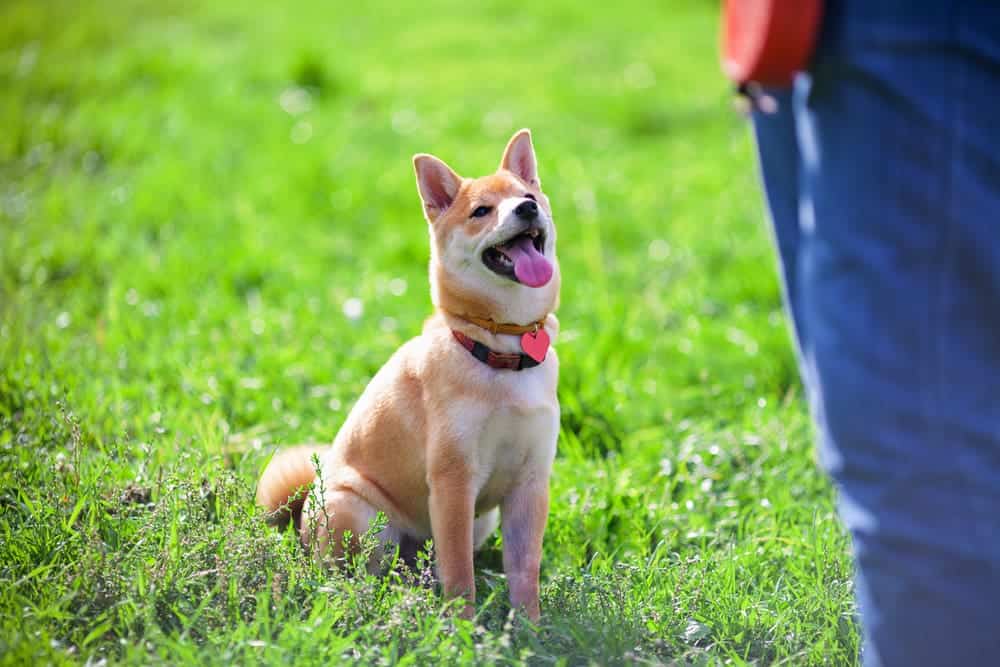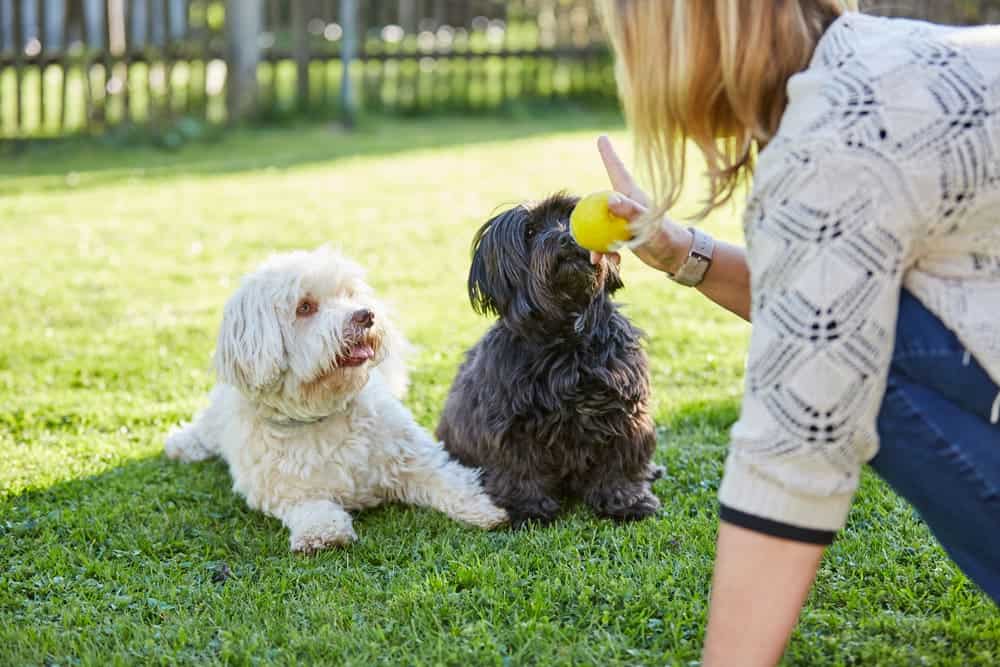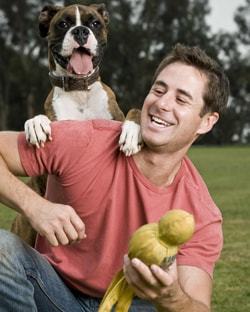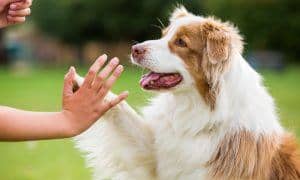“This post contains affiliate links, and I will be compensated if you make a purchase after clicking on my links.”
Sometimes we can feel a little overwhelmed when it comes to teaching our dogs how to behave appropriately. You may even feel like it’s too complicated and you want to give up before you even start. But with a little patience, a positive attitude and just a little dog sense you and your dog can master almost any training together, especially if you keep it fun and light.

But if you don’t even know where to start when it comes to training your dog, why not start with some very basic commands that even the most stubborn or older dog can easily master. I’m going to show you how to approach the three basic behaviors and commands every dog should know for both your benefit and theirs.
With all training, the best approach is positive reinforcement. Not only is this supported by mountains of research, but if you start to experiment yourself, you will quickly learn from the results you get. Follow my guidelines below and I promise you that with positivity, a little patience and practice (consistency and repetition) you and your pup will be ready to move on to the more advanced training in no time.
“Reward the behaviors you want to encourage to prevent the behaviors you want to discourage.”

SIT
When teaching your dog to sit, one of the first things you need to do is teach the behavior before you teach the command. That means that they need to learn what you want them to do before you repeatedly tell them to do it. Follow these steps:
- Take a treat, let your dog smell it and slowly raise it above your dog’s head
- If their bottom hits the ground, reward right away. If they a slower to catch on, then as their hind end starts to go down but stops, give them a treat right away at that point.
- Gradually try to get them to go down further and further and then offer the treat.
- As soon as their behind hits the floor treat right away. Keep in mind that you have one to three seconds to reward a behavior.
- Don’t be frustrated if your dog doesn’t get the sit on the first attempt. It’s more important to end the session on a positive note and come back to it again the next day.
Key to success- don’t ask your dog to do something you aren’t 99% sure they will accomplish. Example: you have mastered SIT indoors, now you need to master it on the busy streets outside. Before you cross the street you ask your dog to sit. You’ve never practiced outside with traffic, people and other dogs… so you say “sit, sit, SIT… come on, SIT!” Get the idea?
STAY
Once your dog has learned how to sit it’s time to teach them how to stay. It’s important to have both a hand sign and a verbal command for stay so that eventually you can give them a hand sign from a distance. Once again, be sure to teach the behavior before you add the command. Follow these steps:
- Hold a treat between your thumb and your hand so that your dog can see it (“palm” it).
- Have the dog sit directly in front of you, show them your hand, count to two and then reward
- Next time show the dog your hand, count to four and then reward. Be sure to use verbal praise as well.
- As you progress, begin to move back by adding small steps.
- Once you know they are starting to understand the behavior, then add the verbal command “stay.”
- As you move back further and further, when it comes time to reward them move back towards your dog gradually, giving them the “stay command” and then treating.
- If you go too far and they can no longer stay, go back to the furthest distance where they succeeded and repeat that.
- Always remember to end on a positive note and continue the training, fresh, the next day.
Remember, your dog’s mind can focus more clearly if you stop, almost like a Polaroid imprint, when you give the command STAY. If you are constantly moving it will be hard for your dog focus.
COME
Before teaching the come (or recall) command, you need to make sure that your dog knows how to sit and stay. Having those two commands mastered makes it possible to master the recall command. Be sure to start in a safe environment with as little distraction as possible but if you do move to the outside or a distracting environment, be sure to use a long leash. Follow these steps:
- Hold a favorite toy or treat in your hand up by your face
- Drop the toy or treat to your side so that it is nose level for your dog making them want to come to you (this will eventually become the hand sign for the command)
- When they come to you all the way, give them the toy or treat and plenty of praise as a reward
- Reset and then start again.
Set your dog up for success! Don’t take them to the dog park and try the come command after practicing for two days. Asking your dog to ‘come’ at a dog park is like asking a child to get out of the pool at a pool party!
General rule of thumb (paw)- It takes a dog two to four weeks to learn a new behavior and three to six months to retain as long term memory. Each time you change the environment, start with the beginning steps for best results.
I hope you have some tremendous success with these tips.
ABOUT TRAVIS BRORSEN

Travis Brorsen is fast becoming one of the most sought after around today. As founder of Greatest American Dog Trainers, he not only continues to provide hands-on training to his canine clients and their humans, but his company is also a veritable “train the trainer” center for the next generation of top dog trainers.
Growing up on a farm in Oklahoma, Travis has been around animals large and small his entire life. However, choosing to pursue a career in entertainment rather than agriculture, he moved to Los Angeles after college where he appeared in more than 20 national commercials and guest starred in several hit shows such as Desperate Housewives, JAG, Bones, Drop Dead Diva and many others.
In 2008, Travis and his 14-month old, highly energetic and untrained boxer, Presley, were selected as contestants for CBS’ national dog training competition, Greatest American Dog. While producers (and Vegas) gave the duo little chance of advancing past the first week, Travis and Presley pushed themselves to their limits and after 12 weeks of grueling competition, beat the odds and won the entire competition.
As a result of the show, Travis discovered he had a passion to help other dogs and their owners create similar positive learning and relationship building experiences and spent the next five years building a highly successful dog training business in Los Angeles. After moving to New York City in 2012 to marry his sweetheart Heather, he founded Greatest American Dog Trainers and can currently can be spotted in Manhattan working intently with a Park Avenue pooch.
Travis was nominated for TV’s Best Dynamic Duo for the Fox Reality Awards, and is a frequent guest on many TV and Radio shows such as Fox and Friends, Animal Planet’s Faithful Friends, National Geographic’s Brain Games, E! and others. He has contributed to many magazines and websites such as Good Housekeeping, Life and Dog Magazine, Boxers Magazine, Star and Hollywood Life. He was also featured in Top Dogs and Their Pets along with other celebrities like Owen Wilson, Nolan Ryan and Lisa Loeb.

















Pingback: The Three Most Dangerous Types of Dogs – Dog Training
Lois Muller
Mar 3, 2018 at 12:27 pm
While I see there is a lot of great advice for training, especially for dogs who have been abused, I need to find advice on how to get my rescue to walk on a leash. She is afraid of collars and the sound of velcro among other things. We finally got a safe harness with clips instead of velcro and she wears it constantly now. IT has a loop on the upper back to clip the leash on. But she goes crazy fighting the idea. It is winter here and both my rescues use piddle pads on the porch. But, with spring coming, we need to get her to manage a leash so she can go outside and walk. Any suggestions would be appreciated as we want to be successful for her. Thanks.
Travis
Mar 4, 2018 at 3:18 pm
Hi Lois,
First, thank you so much for the comment. I am thrilled to be able to reply and help you with your issues. The first thing I tell my clients to do is focus on the issue. What I mean by that is, let’s try to associate the action that your dogs are fearful of before we do it in the real world situation. For instance, major league baseball players don’t see their first pitch in a game. They take hundreds and hundreds of pitches in batting practice so when they get in the game, they have confidence and muscle memory to hit the ball. Your dogs need “batting practice”. (I apologize in advance if you aren’t a baseball fan:) We need to build your dogs confidence. In order to do that, we need to desensitize them to the sounds and movements that they are fearful of. Here’s what you do:
1. At meal time, while they are eating and enjoying their food, put on the harness, clip the leash
2. While they continue to eat, take the harness and leash off
3. Repeat steps 1&2 until dog is finished eating
NOTE: if you dogs are still scared even though you are using food, that means the fear of the element(leash/collar) is higher than their appetite. When this happens, we must use a higher value positive reward to over power their fear. Try using boneless, boiled chicken breast or low fat cheese before meal time to do this activity. Do it 5-10 times per meal. Once they start to get comfortable, then you can go back to using the food.
Walking- If your dogs don’t like walking on the leash, try practicing inside, living room or hallway. Use food or healthy treats BEFORE mealtime so they are extra motivated. Do this before every meal and in between mealtimes. Your dogs need to see the walk as a fun and exciting activity, not just something they do when it’s time to potty. It’s also important to recognize your own energy when going outside. When the weather is bad, I sometimes find myself annoyed to take my own dog out. When I do this, he looks uncomfortable, uneasy and not excited before we ever leave the apartment. Although he may not like the elements, my attitude sure doesn’t help. Keep a positive attitude, stay calm and confident and don’t get frustrated. Easier said then done, I know!
It can take up to 2-4 weeks of doing these things 5-10 times per day before they start to respond. But focus on the short term/daily goals and they will come around. Trust the process. Consistency and repetition are the key as well as using positive rewards to counter condition the pups to teach them this is a good thing, not a bad thing! Please let me know if you have any additional questions and best of luck.